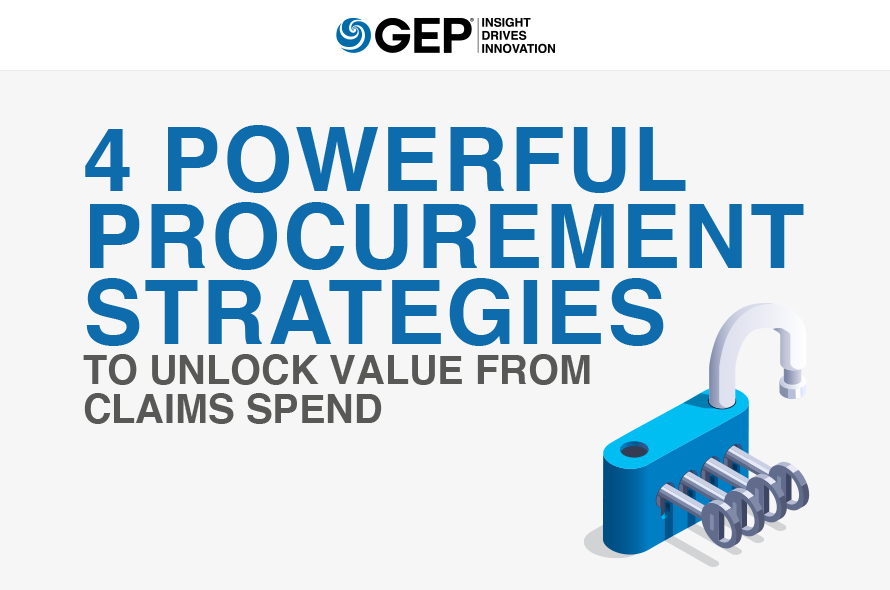For the claims team, there’s no better partner than procurement to reduce costs and create more value for the business. But in most insurance companies, that’s hardly the practice.
Procurement teams are focused on indirect spend, with hardly any visibility and influence on claims spend. It’s an opportunity lost.
What can you do to change the status quo?
In a new bulletin, 4 Powerful Procurement Strategies to Unlock Value from Claims Spend, GEP’s insurance industry experts share how you can build a strong, collaborative partnership with the claims team. These strategies will help you improve customer satisfaction, reduce payouts and boost your bottom line.
Read today to learn how your procurement team can deliver beyond cost reduction and become a strategic partner to the business.
At U.S. insurance companies, policyholders’ claims on an average represent 70% to 75% of the total cost. This makes complete sense, of course, since policyholder benefits are the sole reason why anyone buys insurance products and services.
The problem is, at insurance companies, procurement is limited to supporting indirect spend — real estate, marketing, finance, etc. — which accounts for less than 10% of the organization’s total costs and severely limits our ability to provide substantive value.
So, why doesn’t procurement play a bigger role inside insurance organizations?
First, the independent assessors and the adjustors who handle policyholders’ claims are not in the procurement system. As a result, procurement has no visibility into the organizations’ key vendors. We’re unable to select or evaluate vendor performance, manage the spend, or even influence the administrative expenses incurred in supporting and negotiating appraisers and adjustors.
But the truth is, discrete systems are just a symptom of a deeper issue. The relationship between the chief procurement officer and the chief claims officer is often strained. Claim leaders are inherently guarded since they assume procurement is only focused on cutting costs. And cutting costs from claims is a sacred cow since it undermines policyholders’ indemnities and benefits, and flies in the face of the organization’s core mission, namely driving customer satisfaction.
The net result is that inside insurance companies — a $1.75 trillion U.S. industry — procurement is a relatively marginal player. And chief procurement officers rarely have a seat at the leadership table.
The extraordinary thing is there is no more knowledgeable partner for claims than procurement to drive value. The gulf between the two groups is an opportunity lost.
For procurement leaders to turn things around, and build a strategic, collaborative, and powerful partnership with claims, we must do four things:
1. Use a balanced scorecard to select and evaluate vendors’ contribution
Procurement’s key metric is vendors’ value contribution, not cost. Use qualification, location, risk, and customer satisfaction scores, as well as price, to identify service providers who provide a competitive advantage. In the case of a car accident, third-party administrators (TPAs) are the main contact for policyholders because they handle the entire claims process. By tracking and improving TPAs, auto claims management can yield up to 20% cost reduction and improve customer satisfaction.
2. Provide actionable intelligence about vendors
Even when claims data — preferred vendor panels, terms, volumes and performance — reside on a separate platform, the data can easily be extracted and imported over to track and identify assessors and adjustors who deliver value over time. For instance, most insurance companies will find that local assessors and adjustors, rather than national providers, are rated higher by the policyholders.
3. Use integrated technology and go digital
In the short term, integrate procurement’s source-to-pay system with the claims systems, namely vendor selection, claims evaluation and claims settlement. In the longer term, establish a digital portal where claims vendors register themselves, and the data is exported to both procurement and claims systems.
4. Implement consistent but locally optimized processes
It is imperative for procurement and business teams to get to know others’ priorities before creating value creation programs. Then, for effective implementation, procurement should be organized by regions with claims category management taking place at a local level but overseen by a global category manager in partnership with the business.
Today, procurement in most insurance companies is overlooking its potential to unlock huge value. When procurement is a strategic partner with claims, insurance companies improve customer satisfaction, reputation, renewals and revenue, and reduce claims payout between 1% and 3%, which drops right to the bottom line. This is a massive contribution to the organization and elevates the chief procurement officer to a strategic role.
(This article was originally published in Future of Sourcing.)
TURN IDEAS INTO ACTION. TALK TO GEP
GEP helps enterprise procurement and supply chain teams at hundreds of Fortune 500 and Global 2000 companies rapidly achieve more efficient, more effective operations, with greater reach, improved performance, and increased impact. To learn more about how we can help you, contact us today.
LET'S CONNECT
Tunir Chatterjee
Vice President, Global Delivery, GEP
Tunir has been a vice president at GEP for the last 11 years, working on global business development and consulting services. Additionally, Tunir, who has 22 years of overall experience, coaches and mentors consultants, and promotes learning and thought leadership within the firm.

